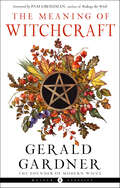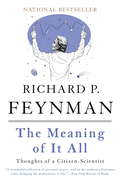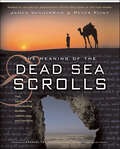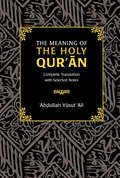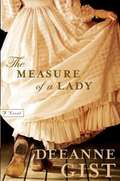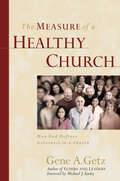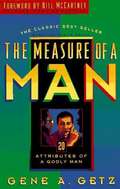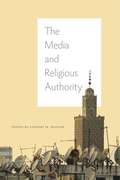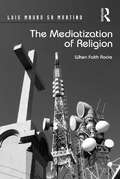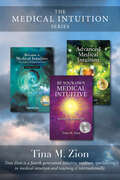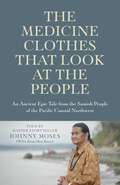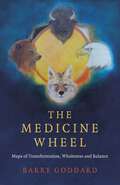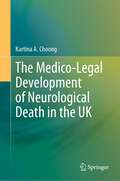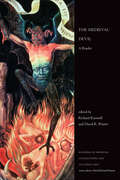- Table View
- List View
The Meaning of Sunday
by Joel ThiessenFewer Canadians identify with a religion, believe in a god, or attend weekly religious services than in past decades. What explains higher and lower levels of religiosity? Is secularization a myth or reality? What impact does religiosity or secularity have on a society's social and civil fabric? In The Meaning of Sunday, Joel Thiessen addresses these questions by weaving together narratives from interviews with members of both religious and secular communities. Exploring the meanings and motivations behind people's religious beliefs and behaviours, the book features discussions with three groups of people: those who attend religious services weekly, those who attend services mainly for religious holidays and rites of passage, and those who do not identify with any religious group and never attend religious services. Interview responses show that religiosity levels correlate to one's personal experiences with the supernatural, religious organizations, and social ties with those who either encourage or discourage religious identification, belief, or practice. Concluding that the demand for religion is waning regardless of what religious groups include in their programs, Thiessen suggests that, apart from some initial social and civic concern, Canadian society may be just fine without it. Testing two dominant theories in the sociology of religion - secularization and rational choice theory - The Meaning of Sunday provides in-depth qualitative research on people's "lived religion" and contributes to a major ongoing debate concerning the nature and importance of religion in contemporary society.
The Meaning of Sunday: The Practice of Belief in a Secular Age
by Joel ThiessenExplaining varying levels of religiosity and church attendance in Canada.
The Meaning of Witchcraft (Weiser Classics Series)
by Gerald Gardner"Those of us who use the word witch with all of the pride and fortification that it offers us do so thanks to Gardner's lucid, liberating vision."—Pam Grossman, author of Waking the Witch: Reflections on Women, Magic, and Power Often called the father of modern witchcraft, Gerald Gardner's life and works were ground-breaking in opening the door for the modern revival of Wicca and neo-paganism. The Meaning of Witchcraft (originally published in 1959) was the first sympathetic book written from the point of view of a practicing witch. "The foundation of magical beliefs," Gardner wrote, "of which witchcraft is a form, is that unseen Powers exist, and that by performing the right sort of ritual, these Powers can be contacted and either forced or persuaded to assist one in some way. People believed this in the Stone Age, and they believe it, consciously or not, today. It is now well known that most superstition is, in fact, broken-down ritual. The meaning of witchcraft is to be found not in strange religious theories about God and Satan but in the deepest levels of the human mind, the collective unconscious, and the earliest developments of human society."The Meaning of Witchcraft is an enduring and invaluable source book for witches today. This Weiser Classics edition includes a new foreword by Pam Grossman, author of Waking the Witch. In it, Grossman revisits the historical role and mixed legacy that Gardner has played in the revival of witchcraft and magic in modern times.
The Meaning of Yiddish
by Benjamin HarshavThis title is part of UC Press's Voices Revived program, which commemorates University of California Press’s mission to seek out and cultivate the brightest minds and give them voice, reach, and impact. Drawing on a backlist dating to 1893, Voices Revived makes high-quality, peer-reviewed scholarship accessible once again using print-on-demand technology. This title was originally published in 1990.
The Meaning of it All: Thoughts of a Citizen-Scientist
by Richard P. FeynmanMany appreciate Richard P. Feynman's contributions to twentieth-century physics, but few realize how engaged he was with the world around him--how deeply and thoughtfully he considered the religious, political, and social issues of his day. Now, a wonderful book--based on a previously unpublished, three-part public lecture he gave at the University of Washington in 1963--shows us this other side of Feynman, as he expounds on the inherent conflict between science and religion, people's distrust of politicians, and our universal fascination with flying saucers, faith healing, and mental telepathy. Here we see Feynman in top form: nearly bursting into a Navajo war chant, then pressing for an overhaul of the English language (if you want to know why Johnny can't read, just look at the spelling of "friend"); and, finally, ruminating on the death of his first wife from tuberculosis. This is quintessential Feynman--reflective, amusing, and ever enlightening.
The Meaning of the Bible: What the Jewish Scriptures and Christian Old Testament Can Teach Us
by Amy-Jill Levine Douglas A. Knight“Both enlightening and inspiring . . . a helpful resource for both Jews and Christians, conservatives and liberals, religious leaders and social reformers.” —Peter J. Paris, the Elmer G. Homrighausen Professor of Christian Social Ethics, emeritus, Princeton Theological SeminaryIn The Meaning of the Bible: What the Jewish Scriptures and Christian Old Testament Can Teach Us, preeminent biblical scholars Douglas A. Knight and Amy-Jill Levine deliver a broad and engaging introduction to the Old Testament—also known as the Tanakh or Hebrew Bible—offering a wealth of compelling historical background and context for the sacred literature that is at the heart of Judaism and Christianity. John Shelby Spong, author of Why Christianity Must Change or Die writes, “Levine and Knight have combined to write a book on the Bible that is as academically brilliant as it is marvelously entertaining. By placing our scriptures into their original Jewish context they have opened up startling and profound new insights. This is a terrific book.”“A winsome, accessible introduction to the theological thought of the Hebrew Bible. This sort of irenic, thoughtful linkage of criticism and interpretation within a confessing tradition is exactly what we most need in Scripture reading.” —Walter Brueggemann, Professor Emeritus, Columbia Theological Seminary“From its superb introduction to its perfectly worded conclusion, this book does it all. Whether your interest in the Bible is historical or literary, specific texts or broad themes, this book has it—and conveys its relevance for today.” —Richard Elliott Friedman, author of Commentary on the Torah“More than random facts about the Hebrew Bible . . . more than a historical overview . . . they are aiming for true understanding of the life, culture, and practices of the ancient Israelites.” —Booklist
The Meaning of the Dead Sea Scrolls
by A. Powell DaviesThe astounding story of the Dead Sea Scrolls with a scholarly interpretation of their relationship to the Holy Scriptures and the origin of Christianity.
The Meaning of the Dead Sea Scrolls: Their Significance For Understanding the Bible, Judaism, Jesus, and Christianity
by James C. Vanderkam Peter FlintThe Dead Sea Scrolls, found in caves near the Dead Sea fifteen miles east of Jerusalem from 1947 to 1956, include the oldest existing biblical manuscripts and the remarkable texts of the purist Jewish community at Qumran. The discovery of the scrolls has added dramatically to our understanding of the varieties of Judaism at the time of Jesus and the rise of Christianity, but has also prompted heated debate about the nature of these religions. As the monumental task of transcribing and translating the Dead Sea Scrolls is finally completed, people around the world are taking stock of the significance of these ancient documents. In this book, two of the world's leading experts on the scrolls reveal the complete and fascinating story in all its detail: the amazing discovery, the intense controversies, and the significant revelations.Drawing together all the evidence, this timely book explores: The discovery and dating of the scrolls Their relationship to the Hebrew Bible, Apocrypha, and New Testament Their messianic and apocalyptic messages The identity, nature, and theology of the Qumran community The nonbiblical scrolls Controversies surrounding the scrollsThis comprehensive, up-to-date guide is the definitive introduction to all aspects of the scrolls, including their teachings, the community that created them, the world of Judaism, the origins of Christianity, our understanding of Jesus and the New Testament. Featuring photos of the original texts, the sites, and the scholars who deciphered them, and including illustrative passages from the scrolls, The Meaning of the Dead Sea Scrolls presents the most complete and accurate scholarship on the Dead Sea Scrolls available today.
The Meaning of the Holy Qur'an
by Abdullah Yusuf AliThis is a compact and revised edition of Abdullah Yusuf Ali's translation of The Meaning of the Holy Qur'an in modern English. It contains complete translation of the Qur'anic text and retains essential notes of Abdullah Yusuf Ali's exhaustive commentary on the Qur'an, which enables the reader to gain a better understanding of the meaning and message of the Qur'an.
The Measure Of A Lady
by Deeanne GistSPEAK POLITELY. Even when you're the only respectable woman around, protesting San Francisco's decadent surrender to gold fever. DRESS MODESTLY. Wear your sunbonnet at all times. Ensure nobody sees your men's boots muddied by the city streets. Remain Devoted to Family. Protect your siblings from the temptations that surround them, even against their wishes. Stand Above Reproach. Most difficult when a captivating man turns out to be a saloon owner. Rise Above Temptation. No accepting gifts. No bestowing favors. No impeachable behavior ... well, maybe just one...little...kiss? WHEN THESE RULES BECOME INCREASINGLY DIFFICULT TO UPHOLD, CAN RACHEL VAN BUREN REMAIN A BEACON OF VIRTUE IN A CITY OF VICE?
The Measure of God: History's Greatest Minds Wrestle with Reconciling Science & Religion
by Larry WithamThe Measure of God is a lively historical narrative offering the reader a sense for what has taken place in the God and science debate over the past century. Modern science came of age at the cusp of the twentieth century. It was a period marked by discovery of radio waves and x rays, use of the first skyscraper, automobile, cinema, and vaccine, and rise of the quantum theory of the atom. This was the close of the Victorian age, and the beginning of the first great wave of scientific challenges to the religious beliefs of the Christian world. Religious thinkers were having to brace themselves. Some raced to show that science did not undermine religious belief. Others tried to reconcile science and faith, and even to show that the tools of science, facts and reason, could support knowledge of God. In the English speaking world, many had espoused such a project, but one figure stands out. Before his death in 1887, the Scottish judge Adam Gifford endowed the Gifford Lectures to keep this debate going, a science haunted debate on "all questions about man's conception of God or the Infinite." The list of Gifford lecturers is a veritable Who's Who of modern scientists, philosophers and theologians: from William James to Karl Barth, Albert Schweitzer to Reinhold Niebuhr, Niels Bohr to Iris Murdoch, from John Dewey to Mary Douglas.
The Measure of Katie Calloway: A Novel
by Serena MillerThe Civil War has ended, but in Katie Calloway's Georgia home conflict still rages. To protect herself and her young brother from her violent and unstable husband, she flees north, finding anonymity and sanctuary as the cook in a Northwoods lumber camp. The camp owner, Robert Foster, wonders if the lovely woman he's hired has the grit to survive the never-ending work and harsh conditions of a remote pine forest in winter. Katie wonders if she can keep her past a secret from a man she is slowly growing to love. <p><p>With grace and skill, Serena Miller brings to life a bygone era. From the ethereal, snowy forest and the warm cookstove to the rowdy shanty boys and the jagged edges of the saw, every detail is perfectly rendered, transporting the reader back to the time when pine was king, men were made of iron, and rivers were choked with logs on the way to the sawmills. Readers will have a hard time leaving the Northwoods when they turn the last page.
The Measure of a Healthy Church: How God Defines Greatness in a Church
by Gene A. GetzIn a world of competing voices about what church is all about, Gene Getz, with the wisdom God has granted him over decades of ministry, provides a solidly grounded and thoroughly biblical approach to how God assesses the strength, health, and maturity of a local church. Previously titled The Measure of a Church.He addresses...-The definition of the church-The standard of measure by which the church should be defined (Is it centered on Christ? Does it display the fruit of the Spirit? Is it growing in its ability to display faith, hope, and love?)-How does one measure leadership?-How does one measure worship?-What is the one, ultimate standard the church is measured by?
The Measure of a Healthy Church: How God Defines Greatness in a Church
by Gene A. GetzIn a world of competing voices about what church is all about, Gene Getz, with the wisdom God has granted him over decades of ministry, provides a solidly grounded and thoroughly biblical approach to how God assesses the strength, health, and maturity of a local church. Previously titled The Measure of a Church.He addresses...-The definition of the church-The standard of measure by which the church should be defined (Is it centered on Christ? Does it display the fruit of the Spirit? Is it growing in its ability to display faith, hope, and love?)-How does one measure leadership?-How does one measure worship?-What is the one, ultimate standard the church is measured by?
The Measure of a Man
by Gene A. GetzA men's devotional book that covers 20 aspects of being a Godly man.
The Media and Religious Authority
by Stewart M. HooverAs the availability and use of media platforms continue to expand, the cultural visibility of religion is on the rise, leading to questions about religious authority: Where does it come from? How is it established? What might be changing it? The contributors to The Media and Religious Authority examine the ways in which new centers of power and influence are emerging as religions seek to “brand” themselves in the media age. Putting their in-depth, incisive studies of particular instances of media production and reception in Asia, Africa, Latin America, and North America into conversation with one another, the volume explores how evolving mediations of religion in various places affect the prospects, aspirations, and durability of religious authority across the globe.An insightful combination of theoretical groundwork and individual case studies, The Media and Religious Authority invites us to rethink the relationships among the media, religion, and culture.The contributors are Karina Kosicki Bellotti, Alexandra Boutros, Pauline Hope Cheong, Peter Horsfield, Christine Hoff Kraemer, Joonseong Lee, Alf Linderman, Bahíyyah Maroon, Montré Aza Missouri, and Emily Zeamer, with an afterword by Lynn Schofield Clark.
The Mediation of the Spirit: Interventions in Practical Theology (Pentecostal Manifestos (PM))
by Mark J. CartledgeA noteworthy theology of the Holy Spirit that challenges current scholarship in the field How might a distinctively Pentecostal and charismatic theological perspective inform and enrich the discourse of academic practical theology? In order to address that question, Mark Cartledge in this book probes the relationship between Scripture, experience, and the Holy Spirit by means of the concept of mediation — that is, how the divine is experienced in the world. An expert in both Pentecostal theology and practical theology, Cartledge offers a unique intervention into practical theology through the lens of the Holy Spirit. He presents an original reading of Pentecost and the Spirit-reception texts in the book of Acts and engages with current literature in both Pentecostal studies and practical theology. Further, Cartledge places his whole discussion within a broader Protestant theological framework, and he interrogates an existing congregational study to provide a real-life example of theological intervention.
The Mediatization of Religion: When Faith Rocks
by Luis Mauro MartinoFilling a significant gap in the literature by offering a theoretical framework by which we can understand the issues of media, religion and politics Luis Mauro Sa Martino asks how can a religious denomination have any sort of influence on people in a secular age? The author presents data which suggests that the presence and influence of religion in public affairs around the world has been strongly supported by the use of media communication, and highlights the way some religions have adopted media communication and drawn on popular culture to build their message. The use of media enables a religion to reach more people, attract more members and generate more income but also increases religious influence on public matters. The book offers a number of case studies and contemporary examples to illustrate the theory, and will be essential reading for all students and scholars of media, politics and all those interested in the part religion plays in our society.
The Medical Intuition series ebook bundle: Six Underlying Causes Of Illness And Unique Healing Methods (Medical Intuition Ser. #2)
by Tina M. ZionAward Winning Medical Intuition SeriesBecome a Medical Intuitive immediately amplifies your intuition and directs you through the primary steps to do medical intuitive readings for others.Advanced Medical Intuition removes blockages, opens the healer within you, and expands your accuracy. Professional intuitives, and newly aware intuitives, will learn creative, new healing processes to help heal others in profound ways.Be Your Own Medical Intuitive speaks to everyone, from all backgrounds, who realize it is time to bring healing into their own body and life now. This book teaches new skills, new techniques and new pathways for permanent, profound healing of your physical body, your energy body and yes, even your soul.
The Medicine Clothes that Look at the People: An Ancient Epic Tale from the Samish People of the Pacific Coastal Northwest
by Johnny MosesAn ancient epic of the United States Pacific Northwest Coast Samish people, transcribed from a live event delivered by spiritual teacher and healer, Johnny Moses, whose traditional name is Whis.stem.men.knee, 'Walking Medicine Robe'. Johnny, a Tulalip Native American, master storyteller and oral historian, carries the Si.Si.Wiss, 'Sacred Breath, Sacred Life' teachings of his peoples. Here, he shares the story of a woman who wears beautiful Medicine Clothes. The woman wears different kinds of clothes when she visits the many different medicine people she is going to get help from, or those she will help. '…Since the beginning of our culture, the First People (Native Americans) have maintained our tradition of storytelling. This was the primary tool for passing on information, for educating, for teaching the philosophy of our culture, for encouraging memory, for highlighting our humor, for focusing on our most talented historians. Johnny Moses brings to this generation the combined gifts of the best of our ancestors...To my knowledge, Johnny is the only individual gifted to relate these ancient stories. He was selected by his elders to listen and to remember each story and their accompanying songs.' Vi Hilbert, Skagit name: Taq.Se.Blu(Excerpt taken from early, self-published edition, by permission of distributor Bear Song Creations, 2014)
The Medicine Wheel: Maps of Transformation, Wholeness and Balance
by Barry GoddardThe Medicine Wheel shows us how to both live and transform ourselves while remaining in balance with the natural world. Indigenous peoples in the Americas, with whom these Wheels originate, have a profound understanding of what it means to be human that has been largely lost in the modern world. This book is not just another &‘self-help&’ guide, but rather an exploration of an ancient map that shows how human beings and the world work. A Wheel is very simple and experiential – dividing the world into the four basic elements of Fire, Water, Earth and Air – and on that basis it creates a deep and transformative psychology, a subtle and practical philosophy and a ceremonial form through which the community can celebrate the sacredness of life.
The Medicine Within: 13 Moons of Indigenous Wisdom, Ancestral Connection and Animal Spirit Guidance
by Asha FrostUnlock the strength and wisdom in your own lineage, connect with ancestral guides and animal spirits, and discover the healing powers of Indigenous Medicine.Follow the path of the 13 Ojibway moons to help you directly experience your own connection to your inherent healing powers. Through storytelling, personal reflections, ceremonies, rituals and shamanic journeys, The Medicine Within shows you how to apply ancient wisdom and ancestral medicine to your life in meaningful ways that are respectful and conscious of the stolen lands, lives and traditions of Indigenous peoples. You'll discover how to:· ground and root yourself in your own lineage and ancestral guides· connect to Spirit and your innate healing powers in your own unique way· practise self-care and rest on your journey· trust and surrender in order to manifest· release self-doubt, fear, disconnection and insecurityIf you feel you don't have access to your roots, ancestors or spiritual connection and you look outside of yourself for answers, you are forgetting the medicine you need lives within you.
The Medico-Legal Development of Neurological Death in the UK
by Kartina A. ChoongDiagnosis of death by neurological criteria (DNC) is a construct which has been part of the British medico-legal landscape for nearly half a century. This book examines the factors behind its emergence, and discusses the various changes that took place in the last few decades that culminated in the current definition and clinical criteria for determining brain-based death. It highlights the continuities and discontinuities in practice, and the impact they have on the issue of withdrawal of mechanical ventilation in intensive care units and on the field of organ transplantation. The book also explores the law’s response to the introduction and development of DNC in clinical practice. It demonstrates how the legitimacy of the definition and criteria used by the medical profession were forged in the courtroom rather than in Parliament. It documents why case law were introduced in court, and assesses whether organ donation was a consideration in the deliberations. It will be emphasised that courts have given insufficient consideration to requests made in recent cases to consider a broader range of methods to determine death. Those pleas were made on the grounds that the definition and criteria used in the UK are dissimilar to those used in other jurisdictions that also adopt DNC; and that faith communities have a different understanding of death. By taking a close look at those other approaches before highlighting the inherent limitations of the courtroom as the forum that confers DNC its legitimacy, the book puts forward the argument that the democratic process should be engaged.
The Medieval Church: From the Dawn of the Middle Ages to the Eve of the Reformation
by Carl A. VolzWhy does one's concept of the medieval church have a direct bearing on one's attitude toward ecumenism? How was Europe evangelized? Why is it essential to understand the different relationships of church-to-state between the West and Byzantium in order to understand the church's role in Eastern culture today? What common practices of public worship and personal piety have their roots in the medieval church? The Medieval Church: From the Dawn of the Middle Ages to the Eve of the Reformation addresses these questions and many more to demonstrate the pervasive influence of the past on modern piety, practice, and beliefs. For many years the Medieval period of church history has been ignored or denigrated as being the "dark ages," an attitude fostered by Enlightenment assumptions. Yet not only does this millennium provide a bridge to the early church, it created modern Europe and its nations, institutions, and the concept of Christendom as well. The Medieval Church, written in an easily accessible style, introduces the reader to the fascinating interplay of authority and dissent, the birth and development of doctrinal beliefs, the spirituality of the common person, and the enduring allure of Christian mysticism. The Medieval Church is a companion to The Early Church: Origins to the Dawn of the Middle Ages by E. Glenn Hinson and The Modern Church: From the Dawn of the Reformation to the Eve of the Third Millennium by Glenn Miller.
The Medieval Devil: A Reader (Readings in Medieval Civilizations and Cultures)
by Richard Raiswell David R. WinterThe Medieval Devil is a unique collection of primary sources that examines the development of medieval society through the lens of how people perceived the devil. In exploring where and how Europeans discerned his presence, detected his machinations, and sought to counter his actions, readers will be afforded a new and important point of entry into medieval history. Each chapter begins with an introduction to familiarize readers with critical issues and to contextualize the primary sources against broader developments of the period. Questions for discussion and reflection, twelve black-and-white illustrations, and a short bibliography are included.

